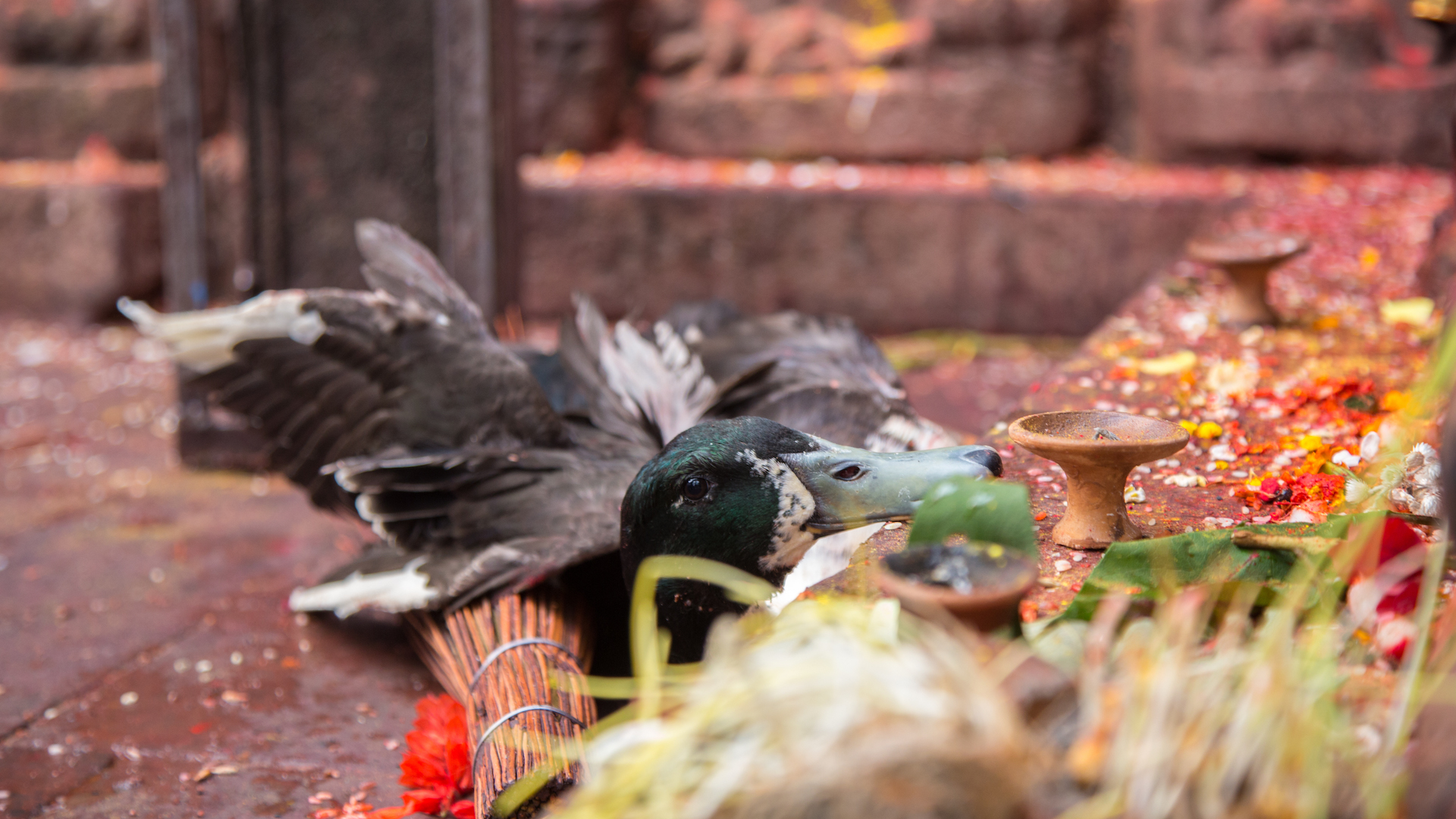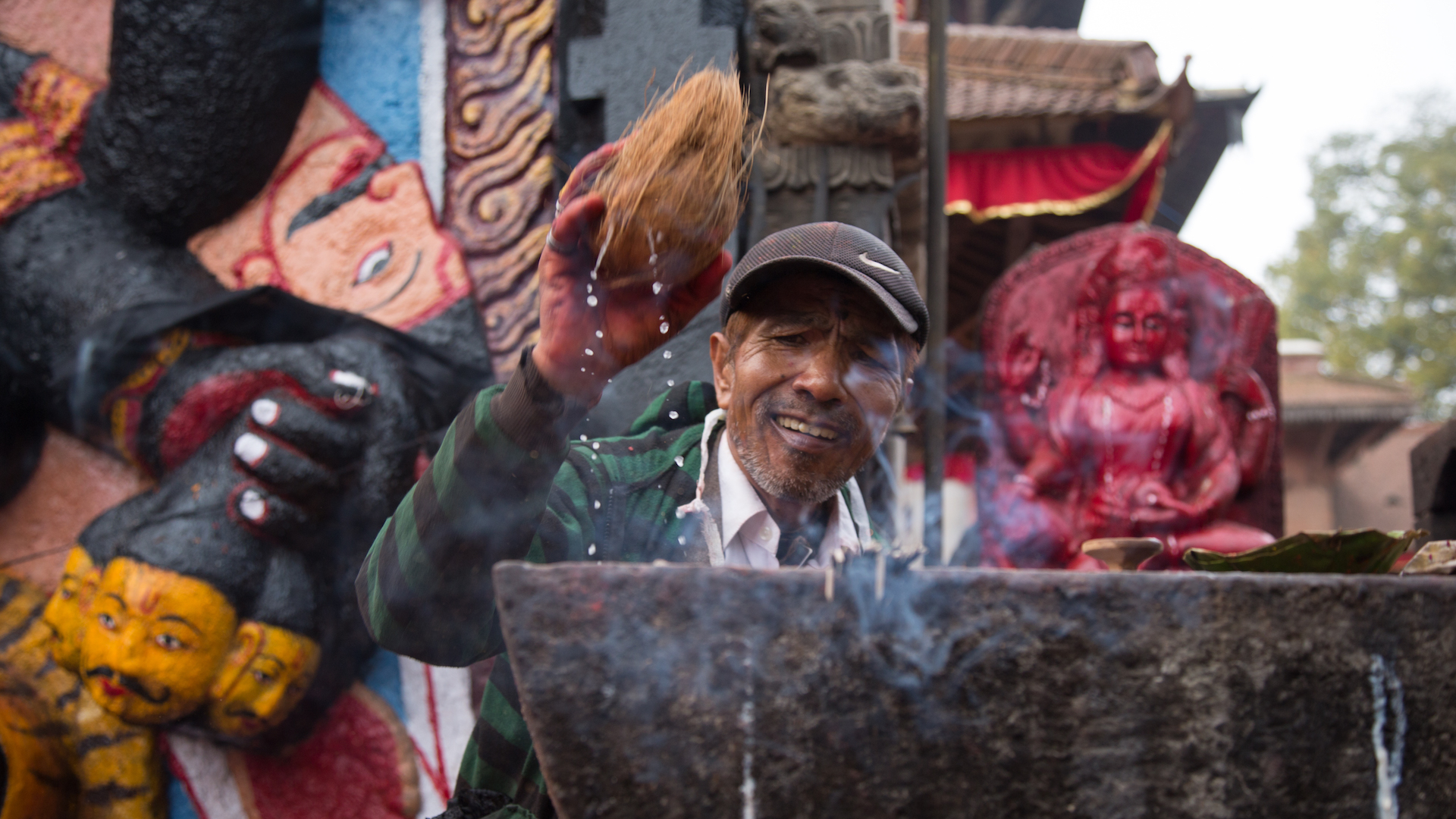
I watched a duck being sacrificed.
He seemed to watch me back in the moments before his death.
I stood a few feet away from it in Kathmandu’s Durbar Square, tears streaming down my face. The duck flailed around, then laid his head on a concrete step in what I imagined as a display of submission and defeat, holding eye contact with me while I stared back.
The solemn moment was interrupted when a man in flip-flops and Chelsea Football Club sweatpants slit the duck’s neck and squeezed its blood over the statue of Bhairava, the Hindu god of annihilation.
The duck’s blood was sprinkled around, and then its body was tossed aside. To worshipers in attendance, he was worth a few drops of blood to appease and please Bhairava. The animal sacrifice will incline the god to grant their wishes.
As I watched this unfold, I hurt for worshipers in attendance because they have no idea they don’t need to sacrifice animals. I yearned to tell them we have already been bought with a price by the one, true God, and no further sacrifice is required for our redemption and salvation.
The Initiation of the Greatest Sacrifice
This December, as I sing, “Joy to the world, the Lord is come,” I’ll be reminded that Jesus came not just to live, but to die. For me, for you, and for the man in the soccer sweatpants who sacrificed a duck to false gods then tried to sell me Kama Sutra paintings.
Jesus’s birth was and is joyous for us, but I imagine his birth was bittersweet for the Father, who knew he was sending his son like a lamb to its slaughter. Jesus’s entrance into the world was the first step toward reconciling sinful humanity and sinless God. And the sacrifice of Jesus as the payment for our sins was public, torturous, and without any semblance of honor.
“Faith in the risen Christ is all we need for unfettered access to God, who permanently views us through the lens of his Son’s righteousness.”
God the Father is pleased in the perfect life of the Son. And his sacrifice—the sacrifice of the perfect, spotless Lamb—is what was required to overcome sin for all time. Isaiah hauntingly said that it pleased the Father to bruise the Son and put him to grief as an offering for sin (Isa. 53:10). His Son was the offering that would end all other offerings (Isa. 1:11) and return the wayward bride back to her Groom (Isa. 62:4).
The duck sacrifice I witnessed can do no such thing. The Nepalese continually slay birds, goats, and other animals to appease their gods. They believe blood sacrifices are required to obtain blessings, escape curses, or receive forgiveness. They have no idea the perfect sacrifice has been made once and for all on their behalf.
Complete in Christ
I wouldn’t have done well in Old Testament times. I would have been a bundle of nerves and tears. I love animals, and the remains of sacrificed ducks, goats, and buffalos that littered Nepal’s capital city nearly made me sick. But their scattered bodies made me imagine what it might have been like to live when animal sacrifices were needed for atonement of sin and were used as voluntary offerings in worship.
Under the old covenant, God’s people offered animal sacrifices on the regular for sin offerings and as free acts of worship (Lev. 1–3; 6:8–23; 7:11–34; 8:18–21; 16:24). Most mandatory sacrifices required blood to be spilt, whether bulls, goats, rams, or doves (Lev. 4; 5:1–19; 6:1–7; 24–30; 7:1–6; 8:14–17; 16:3–22).
Thankfully, that era is over, completed by the Word of God incarnate (John 1:4; Matt. 5:17–18), who took on flesh in Bethlehem. But for millions in South Asia, the era of curse and sacrifice continues in the practice of their Hindu faith.
The Present Reality
Many Hindus sacrifice animals as a regular part of life, particularly during certain religious festivals. During the Nepali festival Dashain, Hindus sacrifice animals for a variety of reasons—to reenact actions of a defeated demon army, to petition protection from evil powers, to abate the rage of bloodthirsty gods and goddesses, and to celebrate good’s triumph over evil.
Hindus also present offerings of garlands, coconuts, and flowers in temples and at idol altars. Temple attendants smear red dye on the worshipers’ foreheads to symbolize a blessing, then break the offered coconuts and sprinkle the juice over the idols. These rituals earn worshipers an audience with the god they want to petition.

A man breaks a coconut on an altar before Kali, the goddess of destruction.
As Christians, we are able to enter God’s presence at any time and in any place (Heb. 4:16) because we have been redeemed through Christ’s sacrifice (Heb. 10:1–10). Goats and calves were not sufficient, so “he entered the Most Holy Place once for all by his own blood, thus obtaining eternal redemption” (Heb. 9:12).
Jesus’s sacrifice ushered in a system whereby we don’t gain God’s affections through our attempts at righteousness. Faith in the risen Christ is all we need for unfettered access to God, who permanently views us through the lens of his Son’s righteousness (2 Cor. 5:21; Rom. 3:21–26; 1 Cor. 1:30).
In the past, I’ve tended to glaze over these passages. Now, having watched the blood of an animal spilled over the pagan altar of a god who is not alive, I have a renewed sense of gratitude for God’s issuance of the New Covenant through Christ.
What Are We Repeating?
What truly pains my heart is the fact that the men and women offering these sacrifices will meet the end of their days and not be reunited with their Creator—unless they hear and receive the gospel. I wish I could unsee the sacrifice. But, I know that my experience deepened my understanding of the gospel and further clarified the need to proclaim it to those who’ve not believed.
Millions of people around the world continue to make sacrifices to false gods, unaware of the final and ultimate sacrifice. The harvest is great, but the workers are few. During this Christmas season, let’s once again commit ourselves to repeat the sounding joy of our Savior’s birth so that all may hear and know that he is God.
Caroline Anderson is a writer and photographer with the IMB. She currently lives in Southeast Asia. Her childhood in Asia consisted of two important ingredients: braving hot chili peppers and telling people about Jesus.

